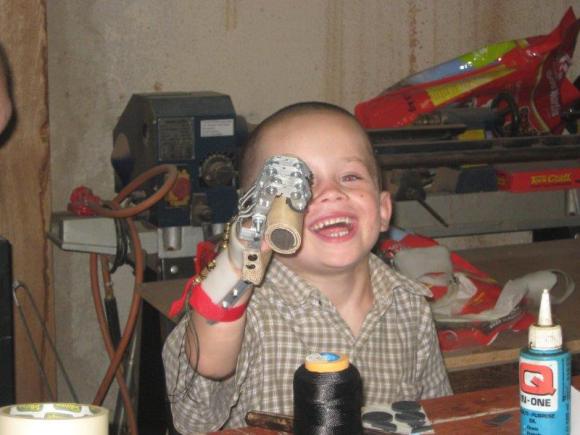3D Printing Extends the Reach of Handicapped Child

The smile says it all as Liam tests out the early prosthetic model that was built from metal parts. Courtesy of Coming Up Shorthanded.
Latest News
January 25, 2013
Additive manufacturing (AM) is making life easier for people in all sorts of ways. Engineers and designers can more easily create prototypes of their designs, and AM molds have made a big impact on many businesses. Sometimes, though, 3D printing helps out in a more direct, personal manner, such is the case with Emma Lavelle’s “magic arms.”
Another example can be found in a 5-year-old boy from South Africa named Liam who was born with Ambiotic Band Syndrome. He has no fingers on his right (dominant) hand and his parent’s aren’t wealthy enough to afford the sort of prosthetic that would make life easier for him. Then they met Richard Van.
Richard has some missing fingers of his own. Rather than being born with a disability, he lost the fingers during a machining accident. Since that time, Richard has been working on affordable prosthetics to assist himself and others with the same disability. The first prosthetic he designed for Liam was a simple sheet of thermal plastic held on with rubber bands that allowed Liam to hold a pencil. A more complex prosthetic would require a far more complicated design.
During his research on prosthetics, Richard came across a video by Ivan Owen, a PLC Programmer/automation technician, living in Washington. Ivan had built a mechanical hand that copied the motions of the user. Richard asked Ivan to work with him to create functional prosthetics to replace missing fingers and, regardless of the 10,000-mile separation, the two began to collaborate.
The first, more advanced design the duo created for Liam was made of metal and it worked. For the first time, he was able to pick up objects on his own. But, although the project had succeeded, Richard and Ivan concluded they could do better, so they turned to 3D printing for help.
They contacted MakerBot for information about the technology, and the company responded by sending them two Replicator 2s, free of charge. One was sent to Ivan and the other was shipped to Richard. Via the Internet, the two collaborated on a new design in real time and, after some final tweaks, the new prosthetic was printed out in 20 minutes.
The improved prosthetic allowed Liam to pick up and play with a ball, bringing a huge smile of joy to the child’s face. Even with that success, Richard and Ivan don’t feel their work is complete and continue to work on improvements. Even more astonishing than the idea of two people separated by a vast distance working together on this ambitious a project is the fact they are releasing their designs for free. The entire project is open source, and the files can be downloaded from Thingiverse.
Even with the good intentions of Richard and Ivan, and the generosity of MakerBot, the project is seeking additional funding. You can find out more about Richard, Ivan and Liam on the project blog, Coming Up Shorthanded.
Below you’ll find a couple videos featuring Liam and the prosthetic.
Source: Coming Up Shorthanded
Subscribe to our FREE magazine, FREE email newsletters or both!
Latest News
About the Author
John NewmanJohn Newman is a Digital Engineering contributor who focuses on 3D printing. Contact him via [email protected] and read his posts on Rapid Ready Technology.
Follow DE






